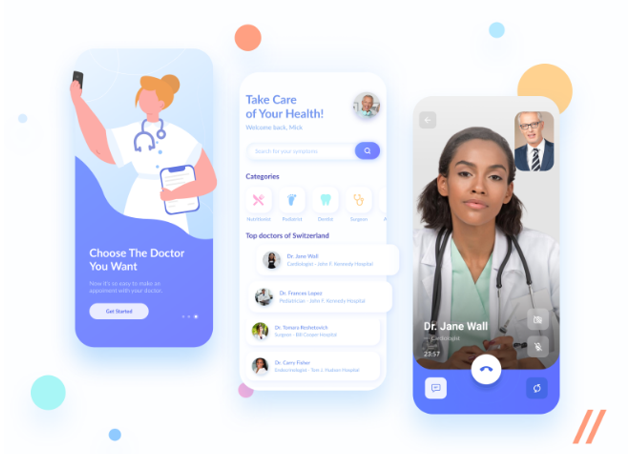
Technological breakthroughs are occurring at a faster rate than you may believe. Every single day brings something new to the world of technology. Dubai Mobile App Developer can help you incorporate these new developments in telemedicine app development and the seven best technologies for creating a telemedicine app.
Contents
1-AI stands for Artificial Intelligence
AI has infiltrated every business, and the healthcare industry is no exception. Artificial intelligence is nothing more than creating computers that can do human-like tasks. Don’t worry, you don’t have to conduct machine learning because it is merely a subset of Artificial Intelligence. However, it can be used in the medical field. There are three primary applications of Artificial intelligence technology in the creation of telemedicine apps:
- Ai systems like chatbots.
- Diagnostics
- Prevention
2-IoT
There is a growing need for telemedicine app development using cutting-edge technologies. This one technology that telemedicine apps require nowadays is the Internet of Things. The major advantage of adopting IoT is that it keeps the patient’s large amounts of data. These systems collect data and then deliver a report to the physicians.
3-AR/VR
Customization has become a required strategy in all fields. AR/VR technology has greatly aided designers in offering customization via telemedicine apps. Artificial intelligence and virtual reality examples readily persuade users. VR technology has the potential to transform the way tools are used to diagnose patients.
The 3D components of VR technology improve the ultimate outcomes of video consultations. However, the point is ruined by the low video quality. Therefore, AR technology has advantages in its manner. Doctors can work on the case more effectively through the telemedicine app if it is used early in the app development process. In a nutshell, AR/VR technologies breathe life into virtual medicines.
4-Blockchain
A telemedicine app transfers patient data to clinicians via video and speech interfaces. Because the internet is insecure, patient data may get into the hands of unscrupulous people while using an online medical program. Blockchain technology protects and encrypts user data against any type of intrusion. All of the worries about the security of telemedicine applications have been addressed by blockchain technology. The sharing of information protected by Blockchain cannot be jeopardized in any other way.
5-Technology for Cloud Storage
Only because of cloud service solutions is data being saved in a revolutionary manner nowadays. IDC predicts that global investment in cloud software development would exceed $500 billion by 2023. Cloud technology allows data to be stored on numerous devices anywhere in the globe and has even had an influence on the telemedicine industry. Check out the entire introduction on cloud-based application development to learn about the benefits, difficulties, and process of creating one for your telemedicine business.
Cloud-based electronic health record systems are available in several telemedicine apps. These EHR systems organize, store, and make vital medical information available to users. Important information such as lab-test progress results, medications, and a patient’s medical information require several levels of protection that only cloud storage technology can provide.
6-Technology for Data Analytics
Every day, telemedicine applications and devices produce a pool of patient and doctor data. This information is saved in the form of reports or lab findings by smart technology such as smartwatches and smart gadgets utilized in the healthcare business. Telehealth applications may employ big data technologies to evaluate this data, perform research, and come up with answers.
They may utilize this data to analyze the trends of people’s health on many factors and enhance the industry’s service with a high rate of development. Data analytics also aids in the modification of telemedicine app development models. Since its introduction, this technology has only benefited the healthcare industry.
7-Tracking through the internet
Telemedicine’s indispensable asset is remote monitoring. The majority of telemedicine-related activities are connected to remote patient monitoring. The coronavirus pandemic has already highlighted the relevance of digital healthcare and its potential future growth. Doctors also appreciate RPM since it allows them to diagnose patients without trying to call them.
Telemonitoring also aids in real-time monitoring, allowing clinicians to make informed judgments. Remote monitoring will become increasingly popular in the next years, thanks to new 5G technologies. As a result, remote monitoring is regarded as the finest telemedicine solution.

